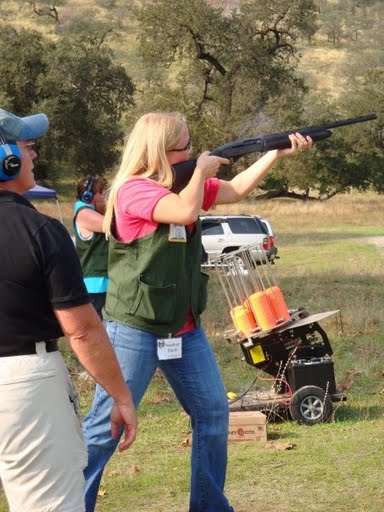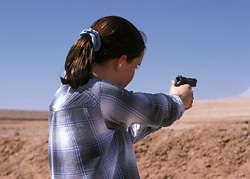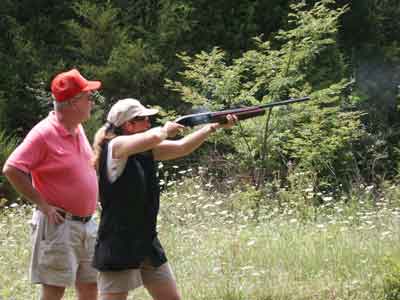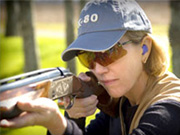One of the greatest joys of shooting and hunting is to share this hobby with your family. Even more enjoyable is having your wife, girlfriend, etc. pick up a gun and discover the same love of our sport.
It is my opinion that you are better off having her learn under the tutelage of someone who is a professional firearms instructor. There are many reasons for this, least among them being the potential emotional harm to your relationship by going it alone. Nonetheless, if you feel you want to plow ahead with teaching, here are some pointers and a basic guide. We are going to explore a few basics to help you negotiate this potential minefield. Some highlights to remember throughout your experience are:
1) Always bear safety in mind. Set the proper example always.
2) Take things slow and easy- from introduction to advanced skills.
3) Try to teach on an isolated range or firing line, if possible.
4) Do not allow a macho attitude to drive a potential shooter from our ranks.
5) Teach in a calm voice, leave the Rambo attitude (and weapons) behind.
6) Let her select a weapon based on fit and function, not your ideas or preferences.
7) Never turn a teaching opportunity into a competition- see #4.
8) If possible, start with an open sighted .22 rifle and stationary fun targets at 25 yards. This makes the activity interesting and rewarding.
9) Do not impose your prejudices on your student shooter.
10) If available in your area, urge her to join a local women’s shooting league club.
Alright, let’s break these down one by one.
Number 1: Always bear safety in mind. Set the proper example always:
This subject is #1 because it is the most important item to bear in mind. No one wants a tragedy or an accidental discharge. A bullet or shot charge cannot be called back or reconsidered. Plant the habit of placing the trigger finger along the trigger guard, never on the trigger. The trigger needn’t be touched before the gun is aimed; only after releasing the safety. If the gun you will use has an external hammer, drill with an empty firearm so there is a clear chamber. Before heading to the gun store or range, review the Ten Commandments Of Firearm Safety. Why do we need the safety rules before we go to the gun store? After all, we won’t be shooting across the counter at the sales clerk! No, we hope you won’t be firing inside the gun store, either. However, do you think the sales clerk or customers want someone waving a weapon around, pointing the muzzle randomly at everyone? Surely not. So, here are the rules:
* Always keep the muzzle pointed in a safe direction.
* Firearms should be unloaded when not actually in use.
* Don’t rely on your gun’s safety mechanism.
* Be sure of your target and what’s beyond it.
* Use clean, serviceable ammunition of the proper caliber for your firearm.
* If your gun fails to fire when the trigger is pulled, wait one minute with the muzzle pointed down range, then remove the dud round.
* Always wear eye and ear protection when shooting.
* Be sure the barrel is clear of obstructions before shooting.
* Don’t alter or modify your gun, and have it serviced regularly.
* Learn the mechanical and handling characteristics of the firearm you are using.
Number 2: Take things slow and easy, from introduction to advanced skills:
This may seem obvious, but how many of us have let our enthusiasm overcome common sense and literally intimidate a student into quitting out of fear of failure or lack of progress? I have seen it happen, and it’s a sure way to lose a possible ally to the anti- gun crowd. Teaching by asking questions is a key technique here. You know your lady best, so you know what will work with her. In some cases, a surprise introductory visit to an indoor range as a date can be exciting. For others, it may take a few weeks of bringing up the subject and exploring her ideas on what she would like.
Number 3: Try to teach on an isolated range or firing line, if possible.
There are enough challenges without Bubba and his friends blasting away with their .44 Magnums nearby, the distractions of an egotistical range officer, and then trying to be heard and understood by your lady. Try and plan a week day lesson when there is less competition at your range. It will pay off in more ways than one- perhaps you might find another pleasant way to spend time together. A well planned briefing at home will go far in preparing her for the range experience. Make sure she has hearing and eye protection in place before entering the lanes or walking up to the firing line.
Number 4: Do not allow a macho attitude to drive a potential shooter from our ranks.
Your lady will not appreciate being told how tiny and wimpy the .22 is which she is just learning to fire. She does not like hearing how big and awesome your “real” gun is, or how you can’t wait for her to graduate to something better (bigger). One sure way to drive off a new shooter is to hand them Grandpa’s old single barrel 12 gauge and watch as the recoil scares (and possibly injures) them. Of course, this gives you bragging rights about how easily you can shoot “old boomer”. Fear of firearms comes in many forms, and recoil is only one. Let’s encourage, praise success, and show patience. We need more shooters and hunters to stand with us against the constant assault on our 2nd Amendment rights.
Number 5: Teach in a calm voice, leave the Rambo attitude (and weapons) behind.
This ties in with #4 above, with perhaps less political component. Still, there is no need to bring along a lot of big guns to impress her. Simply working with a .22 will give her a feeling of power and confidence. Going on and on about how your favorite 227 SuperBoomer can shoot straight as a string out to 400 yards will only kill her drive to improve. Never yell at her or get impatient. If you cannot control yourself, get her signed up with a class which contains other women and let her learn in a non- pressurized environment.
Number 6: Let her select a weapon based on fit and function, not your preferences.
You will have much better results if you can take her to a well stocked gun store and let her handle as many different models as possible. Watch for dominant eye differences as relates to her dominant hand. If she shoulders a rifle on the right and then tries to align the sights with her left eye, you have a situation to deal with. Have her take a simple test to determine her dominant eye. Once you know her dominant eye, she has a choice; train her body to match her eye, or get a firearm that matches her dominant eye. This is of less consequence when speaking about shotguns and handguns than with rifles, as her best shooting is probably done with both eyes open in the former instances.
Number 7: Never turn a teaching opportunity into a competition- see #4.
Belittling the efforts of a novice is never good practice- regardless if the sport is football, dancing, or shooting. Encouragement without negative comment is best. If your lady is flinching, then it may be appropriate to start with an air rifle or pistol in a basement range. Analysis of the root problem is key in teaching and overcoming mistakes. Use this time to build her up, not tear her down. Show her how she might improve, don’t just tell her. It is difficult to place ourselves in the shoes of the one whom we are teaching, but in order to be effective, some understanding of these challenges must be present.
Number 8: If possible, start with an open sighted .22 rifle and stationary fun targets at 25 yards.
Some discussion is due before starting the actual firing sequence, and it starts at home with a diagram of open sights superimposed over a target. Your student must have some concept of what a proper sight picture is. This can be best accomplished by showing two photos; one with the sights only, properly aligned, and another photo with the sights lined up on target. You might ask, “why not a scope?”- and it’s a fair question. It’s true that it is easier to point a crosshair at a target than to align open sights. However, there are other items to consider; if a handgun is being considered, will she encounter scoped handguns every time she shoots? What about rifles? Teaching eye relief for the proper sight picture through the scope and the concept of looking through the scope rather than at the ocular lens are lessons that can wait for a later time.
Number 9: Do not impose your prejudices on your student shooter.
Have you ever been at a gun store and overheard Macho Male telling his petite wife that she needs a .45 ACP in a Kimber CDP? How about the man whose favorite elk rifle is a Remington 700 in .300 Winchester Magnum and decides that wifey needs one also to save on ammo costs? Some practical considerations must enter the equation: If she is choosing a semi- automatic pistol, can she load the magazines and cycle the slide? Does her master (dominant) eye match her weapon? This is critical in rifle shooting, less so with handguns and shotguns which can be mastered with both eyes open. Does the stock or grips fit her? If not, can they be easily modified or replaced?
Number 10: If available, urge her to join a local women’s shooting league or club.
Women’s fitness clubs are a great example of places where women can gather in privacy, work out, and train specific muscle groups unique to women. Internet forums often have a section reserved for the ladies. While your beloved may fit in well with your friends, there may be times where she desires the viewpoints of other women with shooting interests. Perhaps she wishes to branch off on her own and explore sporting clays? These clubs offer gender specific training that “the old man” may not be able to grasp or fine tune.
Mr. Instructor, let’s delve into the finer points and some potential areas which might prove difficult. You need to ask yourself a few questions and mentally prepare for these possible eventualities:
a) Can she handle constructive criticism or correction of a safety rule?
b) Will you be able to stand back and watch as she (naturally) struggles to learn the operation of a gun, or will you be too quick to jump in and fix a “stovepipe jam” for her? We all learn best by doing.
c) How will you handle reluctance to move forward with training if she hits a mental road block in the process?
d) Will you be able to remain emotionally distant (and therefore efficient) in conducting her training?
e) Can you diagnose a shooting error or habit that needs correction?
In summary, if you or your student are not able to keep your relationship issues separate from the learning process, it is better to turn the reigns over to a qualified instructor. Good luck and safe shooting!




![Shooting[1]](https://riflehunter.net/wp-content/uploads/2015/03/Shooting1.jpg)






